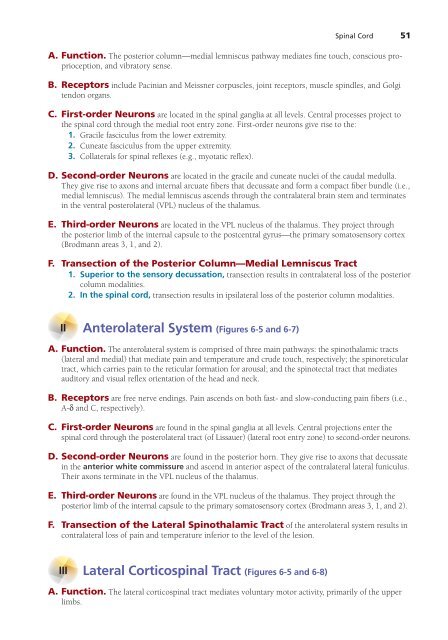Create successful ePaper yourself
Turn your PDF publications into a flip-book with our unique Google optimized e-Paper software.
Spinal Cord 51<br />
A. Function. The posterior column—medial lemniscus pathway mediates fine touch, conscious proprioception,<br />
and vibratory sense.<br />
B. Receptors include Pacinian and Meissner corpuscles, joint receptors, muscle spindles, and Golgi<br />
tendon organs.<br />
C. First-order Neurons are located in the spinal ganglia at all levels. Central processes project to<br />
the spinal cord through the medial root entry zone. First-order neurons give rise to the:<br />
1. Gracile fasciculus from the lower extremity.<br />
2. Cuneate fasciculus from the upper extremity.<br />
3. Collaterals for spinal reflexes (e.g., myotatic reflex).<br />
D. Second-order Neurons are located in the gracile and cuneate nuclei of the caudal medulla.<br />
They give rise to axons and internal arcuate fibers that decussate and form a compact fiber bundle (i.e.,<br />
medial lemniscus). The medial lemniscus ascends through the contralateral brain stem and terminates<br />
in the ventral posterolateral (VPL) nucleus of the thalamus.<br />
E. Third-order Neurons are located in the VPL nucleus of the thalamus. They project through<br />
the posterior limb of the internal capsule to the postcentral gyrus—the primary somatosensory cortex<br />
(Brodmann areas 3, 1, and 2).<br />
F. Transection of the Posterior Column—Medial Lemniscus Tract<br />
1. Superior to the sensory decussation, transection results in contralateral loss of the posterior<br />
column modalities.<br />
2. In the spinal cord, transection results in ipsilateral loss of the posterior column modalities.<br />
II Anterolateral System (Figures 6-5 and 6-7)<br />
A. Function. The anterolateral system is comprised of three main pathways: the spinothalamic tracts<br />
(lateral and medial) that mediate pain and temperature and crude touch, respectively; the spinoreticular<br />
tract, which carries pain to the reticular formation for arousal; and the spinotectal tract that mediates<br />
auditory and visual reflex orientation of the head and neck.<br />
B. Receptors are free nerve endings. Pain ascends on both fast- and slow-conducting pain fibers (i.e.,<br />
A-δ and C, respectively).<br />
C. First-order Neurons are found in the spinal ganglia at all levels. Central projections enter the<br />
spinal cord through the posterolateral tract (of Lissauer) (lateral root entry zone) to second-order neurons.<br />
D. Second-order Neurons are found in the posterior horn. They give rise to axons that decussate<br />
in the anterior white commissure and ascend in anterior aspect of the contralateral lateral funiculus.<br />
Their axons terminate in the VPL nucleus of the thalamus.<br />
E. Third-order Neurons are found in the VPL nucleus of the thalamus. They project through the<br />
posterior limb of the internal capsule to the primary somatosensory cortex (Brodmann areas 3, 1, and 2).<br />
F. Transection of the Lateral Spinothalamic Tract of the anterolateral system results in<br />
contralateral loss of pain and temperature inferior to the level of the lesion.<br />
III Lateral Corticospinal Tract (Figures 6-5 and 6-8)<br />
A. Function. The lateral corticospinal tract mediates voluntary motor activity, primarily of the upper<br />
limbs.


